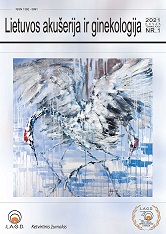SIGNIFICANCE OF THERAPEUTIC HYPOTHERMIA FOR REMOTE OUTCOMES OF TERM NEWBORNS
Abstract
Aim. To determine the influence of therapeutic hypothermia (TH) on the remote outcome of term infants who experienced hypoxia or asphyxia at birth. Methods. A systematic review of the literature was conducted using “PubMed” (MEDLINE) and “Cochrane” electronic medical databases. Selected articles reviewing the rate of therapeutic hypothermia and the impact on early and late outcomes of term infants who experienced hypoxia/asphyxia at birth. Keyword combinations in English were used for the search: “therapeutic hypothermia in neonates”, “neonatal cooling”, “hypoxic-ischemic encephalopathy and cooling“, „cooling asphyxiated newborns“. Filter applied: language “English”, articles not older than “5 years”. 8 publications were selected for this review. Results. After a systematic search total of 7 full text articles were included in the analysis. A total study sample included 2014 neonates. The systematic analysis includes articles from the following countries: USA, UK, Netherlands, Bosnia and Herzegovina. All studies analyzed the significance of TH for remote outcomes in neonates with perinatal asphyxia (PA). Also all researchers described that TH was applied to all resuscitated infants who met the selection criteria according to the protocols. Conclusions. According to the selection criteria for TH, all neonates who experienced asphyxia at birth are given TH. Early remote outcomes in neonates treated with TH are death, HIE and seizures. From 10.8% to 32% subjects who underwent TH died in hospital. Mild HIE had from 14.3% to 16.9% of subjects, moderate - from 52.1% to 88% of subjects, severe - from 12.1% to 28.6% of subjects. Seizure frequency was from 17.9% to 75.9%. The frequency of early outcomes without TH did not differ significantly. Late remote outcomes in neonates treated with TH are disability, motor developmental impairment, CP, hearing, vision, speech, and intellectual impairment. Mild disability ranged from 11% to 21%, moderate from 1.3% to 10%, severe from 11.5% to 25%. Motor development impairment or CP frequency was from 11.9% to 68.9%. The incidence of mild hearing impairment is from 1% to 98.6%, the incidence of mild visual impairment is from 4% to 85.3%, and the incidence of mild speech impairment is from 21% to 74.3%. The frequency of late outcomes without TH did not differ significantly. Only the incidence of mild speech disorders was significantly lower and the IQ was higher with TH.

